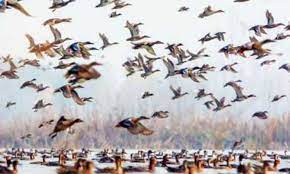Pakistani student contributes to China’s migratory bird conservation efforts

Beijing: As winter sets in, flocks of whooper swans from Siberia migrate to the banks of the Yellow River in Pinglu County, north China’s Shanxi Province. This spectacle attracts numerous tourists and photographers. Pakistani student Anees Ur Rahman was one of them this winter.
“These birds fascinate me and their presence enhances the beauty of our planet,” he told Xinhua. His passion for birds and nature drove him to travel thousands of miles from Pakistan to study wildlife utilization protection at Beijing Forestry University in China. During his time in China, Rahman has regularly participated in field visits and conducted research in the habitats of wild birds across the country, giving him in-depth knowledge of China’s ecological environment and bird conservation efforts. “In recent years, the ecological environment of the Yellow River basin has been continuously improving, and the number of wild swans wintering here has peaked at over 10,000,” said Wang Chao, a staff member of the county’s forestry bureau. China’s bird resources are among the richest in the world, with four of the nine major global bird migration flyways passing through China, according to the National Forestry and Grassland Administration. The administration’s monitoring efforts confirm that the populations of more than 20 rare and endangered bird species in China have increased significantly in recent years. Among these, the crested ibis is especially notable, with its population soaring from only seven in the 1980s to 7,000 this year.
“China’s rich biodiversity and its commitment to environmental conservation were key factors in my decision to study here,” Rahman said, adding that he saw an opportunity to contribute to and learn from this vibrant research community, particularly given the rapid environmental changes in China. To better safeguard migratory birds during their migration, China has set up a comprehensive network to protect migratory birds, including breeding, wintering, and resting stations, and wetlands and natural reserves, covering almost every key node of the migratory bird flyways.
“Over the years, I have witnessed positive changes in China’s environmental practices. Stricter regulations, increased investment in renewable energy, and a growing emphasis on sustainable development indicate a significant shift towards a more environmentally conscious approach,” he said. Thanks to a series of effective protection measures to provide migratory birds with safe habitats and breeding sites, migratory bird populations in China have been constantly growing. The International Union for Conservation of Nature (IUCN) has downgraded the threat of extinction of some rare wildlife in China, including red-crowned cranes and crested ibises. “By continuing my research and engaging in collaborative conservation projects, I aim to contribute to global efforts in wildlife conservation, promoting sustainable practices for the benefit of both wildlife and local communities,” Rahman said.





